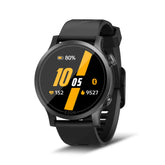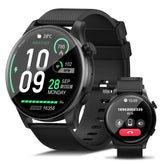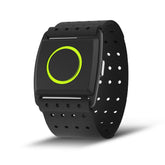Ultimate Guide to Heart Rate Training for Runners: Boost Performance & Avoid Burnout
For runners, training by heart rate is a game-changer—it transforms guesswork into precision, ensuring you build fitness sustainably while chasing race times and fitness goals. This guide breaks down how a heart rate monitor helps craft personalized workouts, identify optimal training zones, and design recovery plans to avoid burnout. Let’s dive into the science of heart rate training and unlock your running potential.
1. Understand Your Heart Rate Zones: The Foundation of Training
A. How to Calculate Key Heart Rate Metrics
- Maximum Heart Rate (MHR): Use the formula \(MHR = 220 - \text{age}\) (or a treadmill test for accuracy).
- Resting Heart Rate (RHR): Measure first thing in the morning—lower RHR indicates better fitness.
- Heart Rate Reserve (HRR): \(HRR = MHR - RHR\), used to calculate training zones via the Karvonen formula:\(\text{Target Heart Rate} = RHR + (HRR \times \text{intensity percentage})\)
B. The 5 Heart Rate Zones for Runners
| Zone | Intensity | Purpose | Effort Level | Example Use |
|---|---|---|---|---|
| 1 | 50–60% HRR | Recovery/Easy Runs | Comfortable, conversational | Long slow distance runs |
| 2 | 60–70% HRR | Aerobic Endurance | Slightly challenging, steady | Base-building workouts |
| 3 | 70–80% HRR | Lactate Threshold | Hard, sustainable effort | Tempo runs |
| 4 | 80–90% HRR | Anaerobic Capacity | Very hard, short durations | Interval training |
| 5 | 90–100% HRR | Max Effort | All-out, short sprints | VO2 max workouts |
2. Designing Workouts for Each Heart Rate Zone
A. Zone 1–2: Build a Strong Aerobic Base
- Goal: Improve fat oxidation, stamina, and recovery.
-
Workouts:
- Easy Runs: 60–90 minutes at Zone 1–2, perfect for 50% of weekly mileage.
- Long Runs: Gradually increase distance (e.g., 10% weekly) at Zone 2 to boost endurance without burnout.
- Tip: Use a heart rate monitor to ensure you’re not overworking—if you can’t speak in full sentences, slow down.
B. Zone 3: Improve Threshold Pace
- Goal: Raise the pace you can sustain for 1–2 hours (critical for half/full marathons).
-
Workouts:
- Tempo Runs: 20–30 minutes at Zone 3 (e.g., 8x2-minute efforts with 1-minute recovery).
- Progression Runs: Start at Zone 2, gradually increase to Zone 3 over 40–60 minutes.
C. Zone 4–5: Boost Speed and VO2 Max
- Goal: Improve leg turnover, lactate tolerance, and race-specific speed.
-
Workouts:
- Intervals: 6x800m at Zone 4 (90-second recovery) for 5K/10K prep.
- Sprints: 10x20-second all-out efforts (Zone 5) with 40-second walks to enhance neuromuscular coordination.
3. Recovery Plans: The Key to Avoiding Overtraining
A. Active Recovery in Zone 1
- What to Do: Walk, stretch, or do yoga at Zone 1 (50–60% HRR) to flush lactic acid and improve mobility.
- Frequency: 1–2 days/week, ideally after hard workouts (Zone 3–5 sessions).
B. Rest Days and Sleep
- Complete Rest: 1 day/week with no structured exercise—use a heart rate monitor to track RHR; a 5–10 BPM increase signals the need for extra rest.
- Sleep Prioritization: 7–9 hours/night to support muscle repair and hormone balance—monitor sleep stages with your heart rate monitor.
C. Deload Weeks
- When to Do It: Every 6–8 weeks, reduce mileage by 40–50% while maintaining intensity to prevent adaptation plateaus.
- Benefits: Reduces injury risk and allows the body to absorb training stress.
4. Using a Heart Rate Monitor: Tools for Precision
A. Key Features to Look For
- Accuracy: Chest-strap monitors (e.g., Polar H10) are most precise; wrist-based models (EZON Heart Rate Series) offer convenience with advanced sensors.
- Real-Time Alerts: Set zone alerts to stay on pace during workouts—vibration notifications prevent over/undertraining.
- Data Analysis: Sync to apps like Strava/TrainingPeaks to review training load, heart rate variability (HRV), and recovery scores.
B. EZON Heart Rate Monitor Advantages
- 24/7 Monitoring: Track RHR, HRV, and sleep quality to adjust training in real time.
- Multi-Sport Modes: Optimized for running, with GPS integration to map pace vs. heart rate on hilly routes.
- Long Battery Life: 20+ hours in training mode, ideal for marathon-distance efforts.
5. Sample 4-Week Heart Rate Training Plan (Half Marathon Focus)
Week 1–2: Base Building
- Monday: Easy Run (Zone 2, 60 minutes)
- Wednesday: Tempo Run (Zone 3, 2x10 minutes with 5-minute recovery)
- Saturday: Long Run (Zone 2, 90 minutes)
- Rest Days: Tuesday, Thursday, Sunday (active recovery or rest)
Week 3–4: Intensity Boost
- Monday: Interval Session (Zone 4, 8x400m with 90-second recovery)
- Wednesday: Progression Run (Zone 2–3, 60 minutes, last 20 minutes at Zone 3)
- Saturday: Race Simulation (Zone 3, 10K at goal pace + heart rate check-ins)
6. Common Mistakes to Avoid
- Ignoring Recovery Metrics: Always check HRV and RHR—high stress + low HRV means scale back.
- Overemphasizing High Intensity: 70% of runs should be in Zone 1–2 to build a sustainable foundation.
- Not Calibrating Your Monitor: Recheck MHR annually or after major fitness changes for accurate zones.
7. Pair Heart Rate Training with Race Goals
- 5K/10K: Prioritize Zone 4 workouts to improve anaerobic capacity.
- Half/Full Marathon: Focus on Zone 2–3 to enhance fuel efficiency and stamina.
- Ultramarathons: Maximize Zone 1–2 mileage to build mental and physical durability.
Train Smarter, Not Harder
A heart rate monitor is more than a tool—it’s your coach, ensuring every workout aligns with your fitness goals while protecting against burnout. By mastering heart rate zones, designing intentional recovery, and leveraging data from your monitor, you’ll run faster, stay injury-free, and enjoy long-term progress.
Ready to transform your training? Strap on your heart rate monitor, define your zones, and let science guide your strides. The path to peak performance starts with understanding your heart—train with purpose, and watch your race times drop while feeling stronger than ever.
EZON Watch: Professional sports technology brand https://ezonwatch.com









